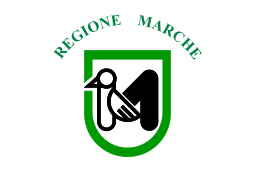Politics of Marche
The Politics of Marche, Italy takes place in a framework of a semi-presidential representative democracy, whereby the President of the Region is the head of government, and of a pluriform multi-party system. Legislative power is vested in the Regional Council, while executive power is exercised by the Regional Government led by the President, who is directly elected by the people. The current Statute, which regulates the functioning of the regional institutions, has been in force since 2004.
 |
|---|
| This article is part of a series on the politics and government of Marche |
|
Prior to the rise of Fascism, most of the deputies elected in Marche were part of the liberal establishment (see Historical Right, Historical Left and Liberals), which governed Italy for decades. The region, especially its northern part (largely inhabited by Romagnoli), was also a stronghold of the Italian Republican Party. In the 1919 general election Marche was one of the regions in which the Italian People's Party, while in the 1924 general election the National Fascist Party took more than 60%.[1]
After World War II Marche was an early stronghold of Christian Democracy and later one of the few regions where the Christian Democrats and the Italian Communist Party were close in terms of the popular vote. However, from 1970 to 1995 the Italian Socialist Party teamed up with the Christian Democrats and long held the presidency, leaving the Communists out of the regional government. Since 1995 the region has been a stronghold of the post-Communist parties, from the Democratic Party of the Left to the present-day Democratic Party, and became part of the so-called "Red belt", along with Emilia-Romagna, Tuscany and Umbria.[2][3][4]
Executive branch
The Regional Government (Giunta Regionale) is presided by the President of the Region (Presidente della Regione), who is elected for a five-year term, and is composed by the President and the Ministers (Assessori), who cannot be more than ten, including a Vice President.[5]
List of Presidents
Legislative branch
The Regional Legislative Assembly of Marche (Assemblea Legislativa Regionale delle Marche) is composed of 40 members. 32 councillors are elected in provincial constituencies by proportional representation using the largest remainder method with a Droop quota and open lists, while 8 councillors (elected in bloc) come from a "regional list", including the President-elect. One seat is reserved for the candidate who comes second. If a coalition wins more than 50% of the total seats in the Council with PR, only 4 candidates from the regional list will be chosen and the number of those elected in provincial constituencies will be 36. If the winning coalition receives less than 40% of votes special seats are added to the Council to ensure a large majority for the President's coalition.[6]
The Council is elected for a five-year term, but, if the President suffers a vote of no confidence, resigns or dies, under the simul stabunt, simul cadent clause introduced in 1999 (literally they will stand together or they will fall together), also the Council is dissolved and a snap election is called.[7]
Local government
Provinces
| Province | Inhabitants | President | Party | Election | |
|---|---|---|---|---|---|
| Ancona | 481,028 | Luigi Cerioni | Democratic Party | 2018 | |
| Pesaro and Urbino | 364,896 | Giuseppe Paolini | Democratic Party | 2018 | |
| Macerata | 324,188 | Antonio Pettinari | Union of the Centre | 2016 | |
| Ascoli Piceno | 214,014 | Sergio Fabiani | Democratic Party | 2018 | |
| Fermo | 177,993 | Moira Canigola | Democratic Party | 2016 | |
Municipalities
Provincial capitals
| Municipality | Inhabitants | Mayor | Party | Election | |
|---|---|---|---|---|---|
| Ancona | 102,500 | Valeria Mancinelli | Democratic Party | 2018 | |
| Ascoli Piceno | 51,168 | Marco Fioravanti | Brothers of Italy | 2019 | |
| Fermo | 37,869 | Paolo Calcinaro | Civic List | 2015 | |
| Macerata | 43,000 | Romano Carancini | Democratic Party | 2015 | |
| Pesaro | 98,438 | Matteo Ricci | Democratic Party | 2019 | |
Other notable municipalities
| Municipality | Inhabitants | Mayor | Party | Election | |
|---|---|---|---|---|---|
| Fano | 63,922 | Massimo Seri | Democratic Party | 2019 | |
| San Benedetto del Tronto | 48,036 | Pasqualino Piunti | Forza Italia | 2016 | |
| Senigallia | 44,673 | Maurizio Mangialardi | Democratic Party | 2015 | |
| Jesi | 40,502 | Massimo Bacci | Independent | 2017 | |
| Civitanova Marche | 40,400 | Fabrizio Ciarapica | Forza Italia | 2017 | |
| Urbino | 15,501 | Maurizio Gambini | Independent (centre-right) | 2019 | |
Parties and elections
Latest regional election
In the latest regional election, which took place on 31 May 2015, Luca Ceriscioli of the Democratic Party (PD) was elected president by defeating a fractured field of opponents, notably including the incumbent president, Gian Mario Spacca, who had switched sides from the PD to a centre-right coalition led by Forza Italia.
Results
 | |||||||||
| Candidates | Votes | % | Seats | Parties | Votes | % | Seats | ||
|---|---|---|---|---|---|---|---|---|---|
| Luca Ceriscioli | 251,050 | 41.07 | 1 | Democratic Party | 186,357 | 35.13 | 15 | ||
| United for Marche (incl. PSI, FdV, IdV, SC) | 26,677 | 5.03 | 2 | ||||||
| Marche Populars–UdC (incl. CD, Demo.S) | 18,109 | 3.41 | 1 | ||||||
| Total | 231.143 | 43.57 | 18 | ||||||
| Giovanni Maggi | 133,178 | 21.78 | – | Five Star Movement | 100,202 | 18.89 | 5 | ||
| Francesco Acquaroli | 116,048 | 18.98 | – | Lega Nord Marche | 69,065 | 13.02 | 3 | ||
| Brothers of Italy | 34,538 | 6.51 | 1 | ||||||
| Total | 103,591 | 19.53 | 4 | ||||||
| Gian Mario Spacca | 86,848 | 14.21 | – | Forza Italia | 49,884 | 9.40 | 2 | ||
| Marche 2020–Popular Area | 21,049 | 3.97 | 1 | ||||||
| Christian Democracy | 4,388 | 0.83 | – | ||||||
| Total | 75,320 | 14.20 | 3 | ||||||
| Edoardo Mentrasti | 24,212 | 3.96 | – | Other Marche–United Left (incl. SEL, PRC, PCd'I) | 20,266 | 3.82 | – | ||
| Invalid votes | 34.605 | – | |||||||
| Total candidates | 645,941 | 100.00 | 1 | Total parties | 530,522 | 100.00 | 30 | ||
| Registered voters | 1,297,485 | 49.78 | |||||||
| Source: Ministry of the Interior – Results | |||||||||
References
- Piergiorgio Corbetta; Maria Serena Piretti, Atlante storico-elettorale d'Italia, Zanichelli, Bologna 2009
- Ceccarini, Luigi; Newell, James L. (2019). The Italian General Election of 2018: Italy in Uncharted Territory. Springer. p. 252. ISBN 9783030136178. Retrieved 15 October 2019.
- Newell, James L. (2010). The Politics of Italy: Governance in a Normal Country. Cambridge University Press. p. 229. ISBN 9781139788892. Retrieved 15 October 2019.
- Barbieri, Giovanni (2012). "The Northern League in the 'Red Belt' of Italy" (PDF). Bulletin of Italian Politics. University of Glasgow. 4 (2): 277–294. ISSN 1759-3077. Retrieved 15 October 2019.
- http://www.regione.marche.it/Home/Istituzione/Giunta.aspx
- La Repubblica – Regional electoral law
- "Regional Council of Lombardy – 1999 Constitutional law" (PDF). Archived from the original (PDF) on 6 March 2009. Retrieved 6 March 2009.